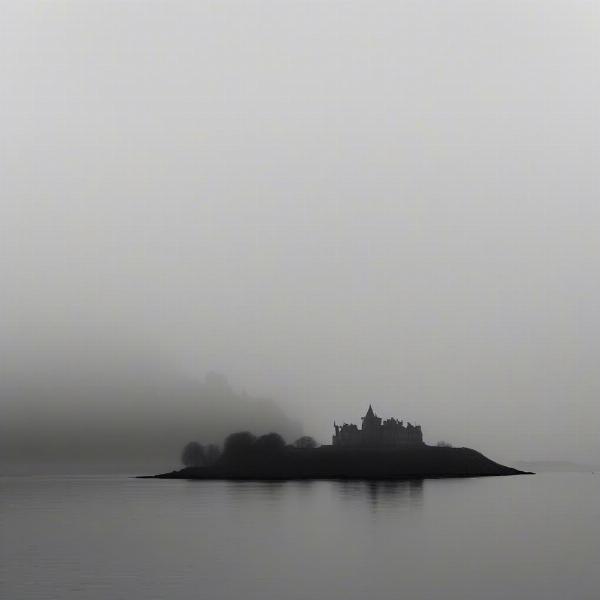Richard Connell’s “The Most Dangerous Game” is a thrilling short story packed with suspense and philosophical questions. Understanding the rising action of this classic tale is key to appreciating its impact. What Is The Rising Action Of The Most Dangerous Game? It’s the series of events that build tension and lead to the climax, where Rainsford confronts General Zaroff in a final, desperate battle for survival.
Rainsford’s Arrival and the Unveiling of the “Game”
Rainsford’s ill-fated fall from his yacht sets the stage for the rising action. He swims to Ship-Trap Island, known for its ominous reputation among sailors. His discovery of a palatial chateau inhabited by the enigmatic General Zaroff marks the beginning of the unsettling unfolding of events. Zaroff, a sophisticated and seemingly hospitable hunter, reveals his boredom with hunting regular game. He explains his new, more dangerous prey: humans. This revelation shocks Rainsford and marks a significant turning point in the story, escalating the tension.
Rainsford’s initial refusal to participate in Zaroff’s twisted game further intensifies the rising action. Zaroff’s insistence and the implicit threat to Rainsford’s safety if he refuses adds another layer of suspense. The reader is left wondering what Rainsford will do, knowing the dire consequences of both choices. This moral dilemma contributes significantly to the story’s overall tension.
The Hunt Begins and the Stakes are Raised
The start of the hunt itself is a crucial element of the rising action. Rainsford uses his cunning and experience to set elaborate traps for Zaroff, delaying the inevitable confrontation. Each trap, while clever, ultimately fails to stop Zaroff, increasing the sense of dread and highlighting the general’s formidable hunting prowess. These initial attempts to outsmart Zaroff build suspense by showcasing both Rainsford’s ingenuity and the sheer power of his adversary.
Zaroff’s pursuit of Rainsford throughout the island contributes heavily to the rising action. The general’s relentless tracking, his almost supernatural ability to find Rainsford’s trail, reinforces the feeling of impending doom. As Rainsford becomes increasingly desperate, the reader becomes more invested in his struggle for survival, wondering if he can possibly outwit the seemingly invincible Zaroff.
Desperation and the Final Confrontation
As the hunt progresses, Rainsford becomes increasingly desperate. He constructs the Burmese Tiger Pit, a complex trap that, despite injuring Zaroff’s dog, fails to stop the general himself. This failure, combined with the constant pressure of being hunted, drives Rainsford to increasingly desperate measures, heightening the tension. The realization that Zaroff is not just a skilled hunter, but a ruthless and intelligent predator, further intensifies the rising action.
Rainsford’s leap from the cliff into the sea, a seemingly suicidal act of desperation, acts as a pivotal point in the rising action. It creates a moment of uncertainty, where both the reader and Zaroff believe Rainsford to be dead. This perceived victory for Zaroff, however, is short-lived, as Rainsford secretly returns to the chateau, setting the stage for the final confrontation. This moment of suspense serves as the bridge between the rising action and the climax of the story.
The Importance of Setting and Atmosphere
The setting of Ship-Trap Island plays a vital role in the rising action. The island’s dark reputation, the dense jungle, and the ominous chateau create a chilling atmosphere of suspense and foreboding. This isolated and sinister setting contributes significantly to the sense of danger and isolation that Rainsford experiences. The island itself becomes a character in the story, adding to the tension and the feeling of inescapable dread.
Zaroff’s opulent yet unsettling chateau further contributes to the rising action. The juxtaposition of luxury and barbarity reflects Zaroff’s twisted psyche, adding a psychological layer to the suspense. The lavish surroundings serve as a constant reminder of Zaroff’s cultured demeanor masking his savage nature, making the threat he poses even more disturbing.
 The Ominous Atmosphere of Ship-Trap Island
The Ominous Atmosphere of Ship-Trap Island
The Psychological Game: Hunter vs. Hunted
The psychological battle between Rainsford and Zaroff is a crucial element of the rising action. As the hunt progresses, Rainsford is forced to confront his own moral code and the limits of his survival instincts. The constant pressure of being hunted, coupled with the knowledge of Zaroff’s twisted philosophy, takes a toll on Rainsford’s mental state, further increasing the tension.
Zaroff’s manipulation and mind games contribute to the psychological tension. He toys with Rainsford, allowing him near escapes, seemingly to prolong the hunt and savor his “prey’s” fear. This cat-and-mouse dynamic adds a layer of psychological depth to the rising action, making it clear that the conflict is not just physical but also a battle of wits.
“The psychological aspect of ‘The Most Dangerous Game’ is just as thrilling as the physical hunt,” says Dr. Emily Carter, Professor of Literature at the University of California, Berkeley. “Connell masterfully portrays the mental toll of being hunted, adding a layer of complexity to the rising action.”
The Significance of the Rising Action
The rising action of “The Most Dangerous Game” is a masterclass in building suspense. Through a series of escalating events, Connell creates a gripping narrative that keeps the reader on the edge of their seat. The combination of physical danger, psychological tension, and a chilling atmosphere makes the rising action a vital component of the story’s overall impact. Understanding the nuances of this rising action allows for a deeper appreciation of the story’s themes and its enduring popularity.
Related Insights: Exploring the Depths of “The Most Dangerous Game”
The Morality of Hunting: A Deeper Dive
The story raises complex questions about the ethics of hunting and the nature of predator and prey. Is hunting for sport ever justifiable? What happens when the lines between hunter and hunted become blurred? These questions add a layer of philosophical depth to the narrative.
The Character of General Zaroff: A Study in Evil
Zaroff’s character is a fascinating study in human psychology. His aristocratic demeanor and sophisticated tastes contrast sharply with his savage desire to hunt humans. Exploring the motivations behind his actions adds another dimension to the story.
Survival of the Fittest: A Darwinian Perspective
“The Most Dangerous Game” can be interpreted through a Darwinian lens. The story explores the themes of survival of the fittest and the primal instincts that drive human behavior in extreme situations.
Conclusion
The rising action of “The Most Dangerous Game” expertly builds suspense, creating a thrilling and thought-provoking narrative. From Rainsford’s arrival on the ominous Ship-Trap Island to his desperate leap into the sea, each event contributes to the escalating tension and sets the stage for the dramatic climax. Understanding this carefully crafted rising action is crucial for appreciating the story’s enduring power and exploring its deeper themes. Share your thoughts on the rising action in the comments below!
FAQ
-
What is the central conflict in “The Most Dangerous Game”?
The central conflict is between Rainsford and General Zaroff, where Rainsford is hunted by Zaroff for sport. -
What are some key events in the rising action?
Rainsford’s arrival on the island, Zaroff’s revelation about his “game,” the start of the hunt, and Rainsford’s increasingly desperate attempts to escape are key events. -
How does the setting contribute to the rising action?
The isolated and ominous setting of Ship-Trap Island creates an atmosphere of suspense and danger. -
What is the significance of Rainsford’s jump from the cliff?
It creates a moment of uncertainty and sets the stage for the final confrontation. -
What is the climax of “The Most Dangerous Game”?
The climax is the final confrontation between Rainsford and Zaroff in Zaroff’s bedroom. -
What are some themes explored in the story?
The story explores themes of survival, the ethics of hunting, and the nature of predator and prey. -
Why is “The Most Dangerous Game” considered a classic?
Its suspenseful plot, compelling characters, and thought-provoking themes have contributed to its enduring popularity.

